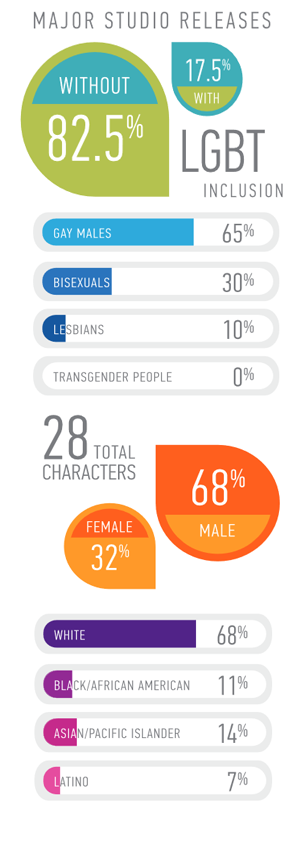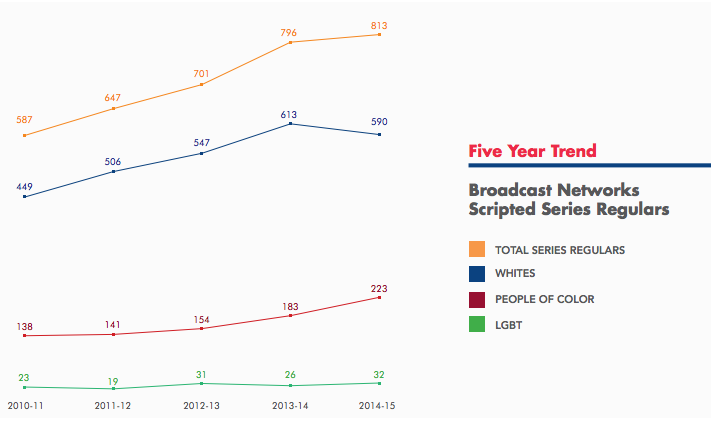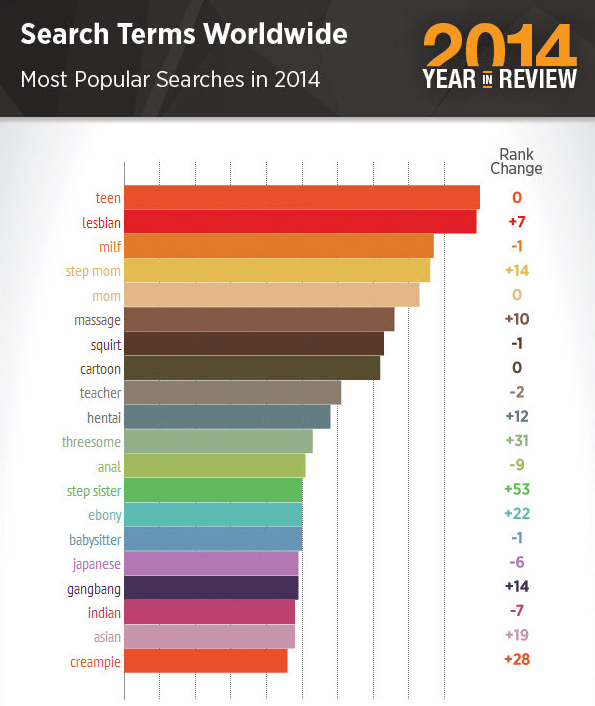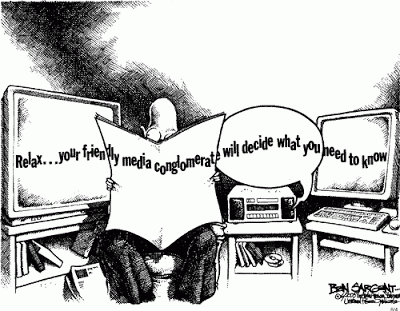Exploring the ‘Coming Out’ phenomenon – an overarching look on LGBT representation in recent popular media
Being an avid consumer of all types of popular media – from films, to TV shows, to newspapers, and magazines – I personally believe that the trend of ‘coming out’ of the closet and announcing ones homosexual or bisexual nature is becoming more and more common these days. I feel that this phenomenon is especially prominent in large, western, popular media-creating countries that I have lived in – namely the U.K and the U.S. From late 90s news about politicians coming out to athletes in major sports stepping out of their cramped locker room closets throughout the 2000s to today’s blatant coverage of LGBT topics on front pages worldwide, whether it’s the first transgender mens magazine cover model or Jaden Smith’s clothing choices, media channels worldwide have definitely shown an increase in coverage of celebrities or popular figures ‘coming out’ in public and proudly wearing their sexuality on their sleeve. I believe that the influence of celebrity role model figures coming out and the mental imprint that media consumption of LGBT related footage or press definitely opens the door a bit wider for members of society at large to feel more comfortable in identifying with their true sexuality and sharing it with others around them. Of course, it is not merely an issue of identification but also a process that involves exploration with a complicated combination of nature and nurture being involved. Ultimately however, my hypothesis is that the presence of popular LGBT role models and the availability and acknowledgement of LGBT subjects in popular media reflects the general trend we are seeing in society at large on openness to LGBT relationships and behavior. To explore this point further I decided to take a dive into some statistics for different forms of popular media.
Film
GLAAD, a media monitoring organization for LGBT representation in popular media publishes a yearly ‘Studio Responsibility
Index‘ that examines the representation of LGBT characters in major hollywood studio releases throughout the past year. An infographic summary of some of their findings to the right shows some of the statistics for the previous year that the organization found. The 17.5 % inclusion rate for 2014 was higher than the 16.7% of films (from the same set of studios) that were found to be inclusive in the previous year. Additionally, some qualitative findings were that comedies were the most likely major studio films to be LGBT-inclusive and that the majority of LGBT depictions in major feature films were minority roles (less than 5 minutes of screen time).
In the context of the studio-system and the Hollywood film industry as a whole, these findings begin to make more sense as the popularity of the ‘gay male comedian’ trope in recent days has seen many studios invest money behind the concept, resulting in more comedies featuring gay male characters. I have personally seen popular actors such as Seth Rogen, Dwayne Johnson, Channing Tatum, Adam Sandler, and James Franco all playing comedic roles involving gay or LGBT themes in films over the past year. However, due to the very fact that comedy is the genre, it is not surprising that GLAAD found evidence of a large amount of self-deprecating jokes scripted for such characters.
Humor is a tricky game but I feel that this tactic was employed primarily for the heterosexual audience who are now more accustomed to not feeling uncomfortable towards LGBT depictions on the big screen due to the growing ubiquity of the concept. Playing into Judith Butler’s theory of gender being essentially performative, one can definitely see the potential for comedy in the unorthodox yet familiar representation of an outright gay male relationship or even ‘bromancing’ on the big screen, tapping into the heart of what makes us laugh. The sense of subtle superiority that heterosexual audiences feel when viewing such performances combined with the distancing from the behaviors exhibited – as the homosexual audience is the minority – naturally serves the studio’s purpose to make the majority laugh and drives revenues.
Television
GLAAD also does a similar report to the one above, for television, called ‘Where we are on TV‘ that summarizes LGBT representation in television. A summary of some of their findings are shown below: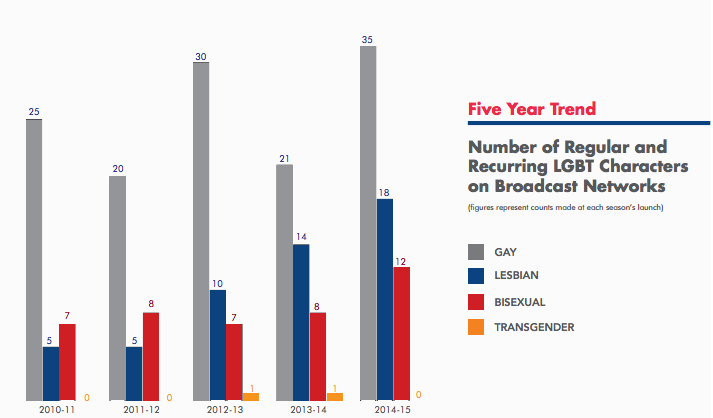
We can see some similarities to the Film report in that transgender numbers are close to zero and that gay characters are the majority among LGBT representations. 2014-15 also shows the highest numbers of LGBT characters when compared to the previous 5 years although there doesn’t seem to be a clearly linear trend of growth. According to Adrienne Shaw, the presence of motivated producers and the existence of a clear market is essential to the production of LGBT content in media. Although we already know there is a reasonably large market for LGBT comedic content (as is evidenced by the major Hollywood studio film releases featuring such content), the presence of LGBT scripted series regulars displays a “dominant discourse” in the industry according to Shaw. The presence of ‘regulars’ on cable and broadcast television proves that the social role of an LGBT character has officially become entrenched in the ‘everyday’ life of both heterosexual and homosexual viewers who live vicariously and identify with the relatable characters in these shows. The tremendous success of shows such as Orange is the New Black and Looking and talk show hosts such as Ellen have undeniably led to more acceptance of LGBT tropes on the small screen.
Pornography
Apart from Film and TV, one other medium that is not often brought up under the umbrella of ‘popular media’ but definitely represents a large portion of ‘public sentiment’ is pornography. To show the depth and breadth of sway that pornography has on the ‘masses’, the infographic below provides some statistics on pornography in general:
 Although traditionally a taboo topic in public spheres, pornography usage worldwide is simply too massive to ignore. With such a large audience and many repeat visitors, Pornography and it’s creators definitely have a significant amount of power in molding how society collectively views sexuality and what is deemed pleasurable in regards to sexual relations. Although the mise-en-scene, casting, stories and tropes that are displayed on porn videos are ultimately up to the creative discretion of porn directors and producers, it can also be said that investment naturally would flow into the production of media that works – in other words, content that draws audiences and eyeballs. To examine what audiences prefer when it comes to their sexual viewing palate, I decided to look into the yearly report for Pornhub, an internet porn website that received over 18 billion total visits over the past year:
Although traditionally a taboo topic in public spheres, pornography usage worldwide is simply too massive to ignore. With such a large audience and many repeat visitors, Pornography and it’s creators definitely have a significant amount of power in molding how society collectively views sexuality and what is deemed pleasurable in regards to sexual relations. Although the mise-en-scene, casting, stories and tropes that are displayed on porn videos are ultimately up to the creative discretion of porn directors and producers, it can also be said that investment naturally would flow into the production of media that works – in other words, content that draws audiences and eyeballs. To examine what audiences prefer when it comes to their sexual viewing palate, I decided to look into the yearly report for Pornhub, an internet porn website that received over 18 billion total visits over the past year:
Looking at these statistics from Pornhub and accounting for the fact that far more males visit the site than females, it is interesting to note that ‘lesbian’ is the second most searched term globally and that it had jumped 7 spots from the previous year’s ranking. Even amongst purely male search categories, ‘Lesbian’ outpaces ‘Gay (male)’. This contrast between the ‘feel good’ vibe given by gay males in popular films and TV shows and the more basic, hedonistic pleasure given by lesbians in pornographic material shows the attractiveness of the Lesbian trope as a sexual concept and the Gay trope as more of a social concept. I believe part of this trend may have to do with the ‘invasive’ factor involved in gay porn with male masturbation behavior not normally involving anal penetration while female masturbative practices often involve external vaginal stimulation. However, there is also ‘word-of-mouth’ evidence for more and more gay porn(a significantly searched category, even solely amongst males, as seen above) viewers beginning to question their sexuality and to develop a sense of curiosity to explore their homo-erotic desires.
Culture Creation
When exposed to media from so many angles on daily basis, whether it is TV, Film, Youtube, or PornHub, all of us are deeply influenced by the tropes and representations we witness. Instead of being purely reactive actors to market demands, media creators also actively push creative boundaries and create a market for their content, echoing the same sentiment as Steve Jobs did with Apple. As such, we can realize that popular media is essentially a culture creator as well as a cultural mirror. Representing the current state of society is essential for popular media to relate with audiences and draw viewers, and when viewing the above statistics for film, TV, and pornography, one can definitely see the niche that LGBT content has carved for itself in audiences’ consciousness and the slowly increasing relevance of LGBT tropes and characters on these mediums.
Some questions to think about when pondering the future of media creation and the inclination of more and more hidden LGBT individuals to ‘come out’ are whether western society is still very much patriarchal in nature – relegating gay relationships to comedic roles while fetishizing lesbianism in the sexual arena? Although the LGBT community has definitely been brought to the ‘mainstream’ in recent years, does there have to be a critical mass reached with the LGBT population globally in order to push LGBT representations into the realm of the ‘norm’ and not merely as a comedic or marginalized role? Are LGBT relations truly ‘normalized’ in the public conscience today or will they ever be (despite the ardent efforts of pro-LGBT producers and directors)? Assuming that media creators have a responsibility to enforce social norms through the representations in their creations, the normative argument of whether creators should produce more LGBT content (thus possibly inspiring more LGBT sentiment amongst otherwise heterosexually identified individuals) also arises. I am quite interested in actively playing a part in this debate and would love to hear your thoughts and arguments as readers in the comments!
